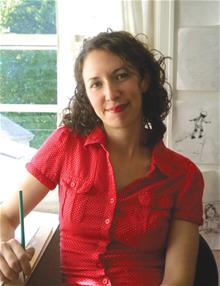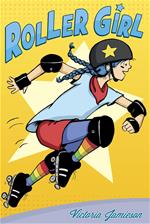
There are ways in which roller derby is a lot like life. It moves fast, it can be slippery, sometimes you get a little bruised—physically and emotionally.
When Victoria Jamieson saw those connections, she turned it into Roller Girl, her latest graphic novel. In it she also follows the theme of many of her other books: Sometimes no matter how hard you try, you still fail. And that’s OK. Jamieson knows that’s a hard lesson to learn, even for adults, but she keeps reinforcing it for her readers.
In Olympig! and Roller Girl, you aren’t afraid to show that sometimes, even when you tried really hard, you can fail. Do you think students are told enough that failing IS an option?
I know it was a tough lesson for me to learn as a kid. Instead of being told that failure is an option, I was more likely to hear, “If you try really hard, you can do anything you put your mind to.” That’s an important sentiment, but sometimes when the big game, test, or competition comes around, you try really hard and still fail. For example, Olympig! was born out of the memory of a Kid Olympics we had on my block when I was 6 years old. I was obsessed with Mary Lou Retton and was determined to win the gold medal (tin foil) in gymnastics. I practiced for weeks, tried really hard and—lost. I was devastated, because I wasn’t prepared for the fact that I could practice hard, try my best, and still lose. As an adult, this still happens of course, and I don’t think the pain gets any easier to bear! As an author, I think this is great fodder for stories—how do you rebound from crushing defeat? It’s a real test of character.
You are a roller girl yourself. How far were you into roller derby before you thought, “This would be a great book concept for kids”?
 I first learned about roller derby through a YA novel (Derby Girl, by Shauna Cross; later renamed Whip It after it was turned into a movie). At first, I was not thinking at all about writing a book about derby; it was a new and exciting obsession, but it took all my energy just to learn how to skate. As time went on and derby became more integrated into my daily life, I began to see how “real life” and roller derby intersected and informed one another. I began making little “mini-comics” about my personal trials and tribulations with the sport. At the same time, junior roller derby for skaters ages 12–17 was becoming more and more popular. I finally felt ready to write a longer story about roller derby, and a story about junior derby told as a graphic novel seemed like a perfect match.
I first learned about roller derby through a YA novel (Derby Girl, by Shauna Cross; later renamed Whip It after it was turned into a movie). At first, I was not thinking at all about writing a book about derby; it was a new and exciting obsession, but it took all my energy just to learn how to skate. As time went on and derby became more integrated into my daily life, I began to see how “real life” and roller derby intersected and informed one another. I began making little “mini-comics” about my personal trials and tribulations with the sport. At the same time, junior roller derby for skaters ages 12–17 was becoming more and more popular. I finally felt ready to write a longer story about roller derby, and a story about junior derby told as a graphic novel seemed like a perfect match.
I’m sure you’ve been asked this a million times, but… What is it like as a woman creating graphic novels, and has that changed since you began in picture books?
I am very lucky that my book came out in the PRT (Post–Raina Telegemeier) age. I am not even sure that I would have considered a graphic novel format if I had not read Smile and thought, “Yes! This is the type of book for older readers I want to write!” And of course, the month before Roller Girl was published, Cece Bell won the Newbery Honor for her graphic novel El Deafo. So I am very lucky and grateful for the achievements of these trailblazing women. Honestly, when I decided to write a graphic novel I was less concerned about being a woman, and more concerned with not knowing very much about the comics industry. I didn’t read comic books growing up, I wasn’t interested in superheroes, and I wasn’t aware of anything beyond that in comics. I loved comic strips like “For Better or For Worse” and “Calvin and Hobbes,” but that was about the extent of my knowledge. In that respect, I am also thankful to the work of Matt Phelan and Jarrett J. Krosoczka; I watched as they transitioned from picture books to graphic novels, and it gave me the courage to try it too.
What’s your process for picture books compared with graphic novels?
The process for writing both is actually quite similar! I tend to spend a lot of time thinking about my characters first. I doodle, draw, and daydream for quite some time before worrying too much about the details of the plot. As I get to know the characters more, I can start to think more concretely about the story. For both picture books and graphic novels, I like to think of the story as an arc. Who is the character at the beginning of the story? What is his or her struggle? What is the emotional climax of the story? How has the character changed by the end of the book? The transition from picture book to graphic novel was actually much smoother than I had envisioned, because I could apply this same “formula” to both.
Recently, William Joyce released Billy’s Booger, a revision of the very first book he wrote in elementary school. You’ve mentioned Super Cow! as your first book. Would you ever go back and revise that?
I didn’t know Billy’s Booger was a revision of a childhood book! I also love No, David! which, as David Shannon explains in the author’s note, is a revision of the first book he wrote as a child. So maybe you’re on to something! I know my mom would be thrilled; I think it is still her favorite book that I’ve written. I’ll need to revisit the ending, because if I remember correctly, Super Cow! ends with the statement, “… and it was all a dream!”. I’m not sure if that ending will “fly”—har har!
 April Hall is editor of Literacy Daily. A journalist for about 20 years, she has specialized in education, writing and editing for newspapers, websites, and magazines.
April Hall is editor of Literacy Daily. A journalist for about 20 years, she has specialized in education, writing and editing for newspapers, websites, and magazines.